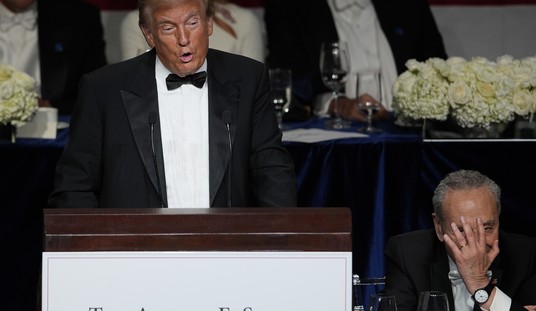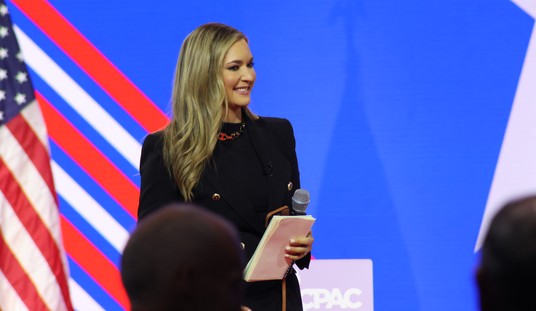Whether Guy Snodgrass really is “Anonymous,” as this New Republic analysis proposes, or just the lucky beneficiary of a case of mistaken identity, he has every incentive to play coy about it. Why? Because Snodgrass has his own book out right now called “Holding The Line” about his time as chief speechwriter for James Mattis while Mattis was secretary of defense.
He’s going to sell some extra copies of that one whether or not he’s also the unnamed author of “A Warning.”
So go figure that he would agree to answer questions about it on Fox News this afternoon while refusing to confirm or deny the accusation. Let people wonder! It’s more royalties for him.
Guy Snodgrass refuses to confirm or deny authoring the book “Anonymous”
“I was going to make an announcement like that I’d do it right, I’d come into the studio with you there in New York City”
— Benny (@bennyjohnson) November 25, 2019
He’s milking the New Republic piece for attention on Twitter too:
The swirl continues…https://t.co/BCth6lqnLM
— Guy Snodgrass (@GuySnodgrass) November 25, 2019
The theory that Snodgrass is “Anonymous” comes from a former Clinton speechwriter, David Kusnet, who claims he figured out the true identity of the author of the last “anonymous” book to make literary waves, “Primary Colors,” before Joe Klein revealed himself. As a writer himself, Kusnet understands that all writers have individual tics — certain phrases they’ll use, particular analytical gimmicks, even a preference for some kinds of “rhythm” over others. He suspects “Anonymous” is a speechwriter, which limits the pool of suspects inside the Trump administration significantly. From there it’s a matter of piecing together other clues:
First, A Warning and the original op-ed both read like they were written by a speechwriter. They both feature short sentences and one-line paragraphs, the frequent use of alliteration, and “reversible raincoat” constructions (Lincoln had a “team of rivals,” Trump has “rival teams”). The two texts also repeat the same words or phrases but in different contexts (as in, “The United States can have an open door without having open borders.”) These tics all reflect a speechwriter’s mandate of writing for the ear as well as the eye…
Reading Snodgrass’s Pentagon memoir, Holding the Line, makes the clues to Anonymous’s identity apparent. As in A Warning, the sentences and paragraphs are pithy and punchy. Every chapter in both books begins with an inspiring but not cliché quotation from a historic figure. Many passages in the books are remarkably similar: the ordeal of conducting a Pentagon briefing for Trump; national security staffers exchanging appalled asides about Trump’s conduct of foreign policy via Twitter; and the arguments for why American alliances strengthen national security and why immigration policy shouldn’t be based on building a border wall. In particular, both books stress that, when briefed about international alliances, Trump derails discussions by griping about how allies are stiffing the U.S., from allegedly miserly NATO contributions to ostensibly one-sided trade policies.
In another revealing quirk, Snodgrass shares Anonymous’s habit of categorizing his cast of characters. Thus, the op-ed distinguishes between the “deep state” that Trump denounces, the “steady state” that Anonymous praises, and the liberal “resistance,” from which he distances himself. Toward the end of A Warning, the author divides Trump’s staff into the Lackeys (true believers), the Steady Staters (capable colleagues), and the Abettors (who neither support nor subvert Trump’s worst goals). He divides the last group, in turn, into the Apologists (who “often display a telltale trait: smiling and nodding at the wrong time”) and the Silent Abettors (who keep quiet but, as he acknowledges, may include some secret, surviving Steady Staters). Similarly, in Holding the Line, Snodgrass classifies two kinds of senior leaders around Mattis: “attenuators,” who took his bad moods in stride, and “amplifiers,” who passed along his harshest criticisms, unfiltered, to their subordinates.
Thematically the two books are similar as well. The publisher description of “Holding The Line” at Amazon reads, “For nearly two years as Trump’s Secretary of Defense, General James Mattis maintained a complicated relationship with the President. A lifelong Marine widely considered to be one of America’s greatest generals, Mattis was committed to keeping America safe. Yet he served a President whose actions were frequently unpredictable and impulsive with far-reaching consequences.” That’s the thrust of “A Warning” and the original “Anonymous” op-ed as well — Trump is a bull in a china shop and it’s up to the “adults in the room” around him to try to stop him from wrecking everything. “A Warning” also praises Mattis a lot, according to Kusnet,
And coincidentally, Snodgrass and “Anonymous” have the same literary agent.
Any reason *not* to think Snodgrass is the mystery author? Well, the famous NYT op-ed was titled “I Am Part of the Resistance Inside the Trump Administration” and published on September 5, 2018. Snodgrass left the government a month earlier, so if it’s him then the op-ed should have been called “I Was Part of the Resistance.” The op-ed also described the author as “a senior official in the Trump administration.” Even allowing for the fact that “senior official” can be stretched to encompass nearly any position, does the secretary of defense’s speechwriter really qualify as a “senior official”? Kusnet himself notes some details that don’t jibe with Snodgrass’s bio, like the fact that “Anonymous” hints at having worked on the Trump transition — Snodgrass didn’t — and seems to have been present at meetings that Snodgrass wouldn’t have attended.
Also, didn’t “Anonymous” say in the book that he’d lie flat out if accused?
This is odd. In the anonymous book, the writer pledges to “strenuously deny” being the author if asked. This response below sounds more like a guy who is about to own up — or someone who is not Anonymous but hopes to use this hoopla sell a few more copies of his actual book! https://t.co/MtCQiTEfnK
— Carlos Lozada (@CarlosLozadaWP) November 25, 2019
It could be that Snodgrass wrote it but a lot of the information in the book is secondhand. Or maybe “Anonymous” is actually a collection of officials, one of whom is Snodgrass. That might explain why the writing in “A Warning” sounds like his own. If he’s part of a group of anti-Trump administration vets, it stands to reason that the practiced speechwriter among them would be tasked with piecing their individual recollections together into a manuscript.
If you think it’s Snodgrass, though, then an obvious question must be answered: Why write two books? Why not just put all of the “Anonymous” material in “Holding The Line”? The cynical answer is that it’s a cash grab, and a clever one. Snodgrass knew “A Warning” would sell and that “Holding The Line” wouldn’t, so he used the former to generate interest in the latter. Double the royalties, double the fun. The less cynical answer is that he didn’t want to tar Mattis by associating him with “Anonymous,” knowing how much Republican animosity exists towards the latter. So he wrote a straightforward, if Trump-skeptical, account of his experience with Mattis at Trump’s Pentagon in one book and saved the more polemical stuff for the other. Remember that the “Anonymous” book also refers sensationally to chitchat that the author heard early on in Trump’s presidency about a 25th Amendment effort to remove the president. If Snodgrass identified himself as “Anonymous,” suspicion would immediately fall on Mattis as having been a ringleader of that alleged effort. Or the reason for two books may be simpler: Since Mattis has conspicuously dodged criticizing Trump since leaving the Pentagon, evidently feeling it’d be dishonorable to do so, maybe Snodgrass decided that it’d be unfair to his old boss to put his more polemical anti-Trump musings in a book like “Holding The Line” about Mattis’s department.
Lots of questions, few answers — so far. My favorite theory, though, is that Mattis is “Anonymous” and that Snodgrass, his former speechwriter, ghost-wrote the op-ed and book for him. That would explain why “A Warning” sounds like Snodgrass but why it was attributed to a “senior official” who’s otherwise reluctant to state his dim view of the president on the record.
Here’s the man himself a few weeks ago on CNN discussing the book which we know for a fact that he actually wrote.







Join the conversation as a VIP Member